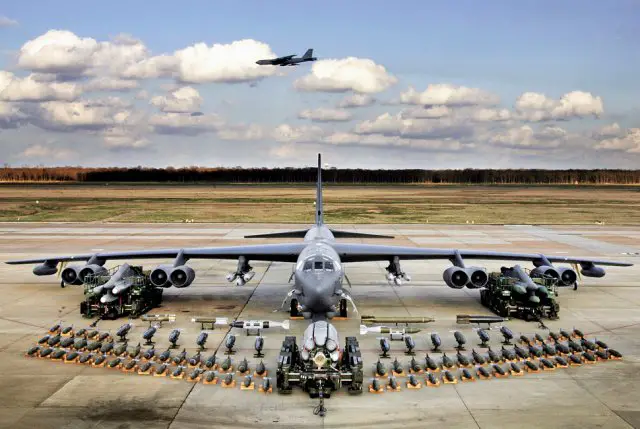The Boeing B-52 Stratofortress is a long-range, subsonic, jet-powered strategic bomber, heavy bomber designed and built by Boeing Company (Boeing Military Airplane Co.). It has been operated by the United States Air Force (USAF) since the 1950s.
The B-52 began life in 1948 as a replacement for the B-50 Superfortress and eventually the B-36 Peacemaker bombers.
The original B-52 concept was to be powered by turboprops owing to their much lower fuel consumption when compared to early turbojet engines. The disadvantage of this class of engines is their greater complexity and reduced reliability. Tupolev had also made the same tradeoff in developing its Tu-95 bomber. Luckily, Pratt & Whitney subsequently unveiled the J57 turbojet in 1949. The J57 offered significantly better performance than previous turbojets and allowed Boeing to redesign its B-52 proposal.
As of 2012, 85 were in active service with nine in reserve. The bombers flew under the Strategic Air Command (SAC) until it was inactivated in 1992 and its aircraft absorbed into the Air Combat Command (ACC); in 2010 all B-52 Stratofortresses were transferred from the ACC to the new Air Force Global Strike Command (AFGSC). Superior performance at high subsonic speeds and relatively low operating costs have kept the B-52 in service despite the advent of later, more advanced aircraft, including the canceled Mach 3 B-70 Valkyrie, the variable-geometry B-1 Lancer, and the stealth B-2 Spirit. The B-52 completed fifty years of continuous service with its original operator in 2005. After being upgraded between 2013 and 2015, it is expected to serve into the 2040s.
A series of major upgrade programs began during the 1980s to extend the service life of the B-52 fleet into the 21st century. First of these was the Offensive Avionics System (OAS) upgrade that improved the navigation and weapon delivery systems of the B-52G and B-52H. Both models were also modified to carry the AGM-69 Short-Range Attack Missile (SRAM) and AGM-86 Air Launched Cruise Missile (ALCM) internally as well as on wing pylons. The B-52 fleet has also been extensively updated with more capable ECM protection in addition to an electro-optic viewing system and FLIR sensors in the nose. Furthermore, the radar was given an improved terrain-following capability for low-level missions.
Once the Cold War came to an end, the nuclear deterrent duties of the B-52 became less critical and the fleet was adapted to a more conventional role. This change in priorities led the Air Force to retire the B-52G by 1994 and transfer its duties to the B-52H. New weapons that have been integrated aboard the B-52 include the stealthy Advanced Cruise Missile, an ALCM variant armed with a conventional warhead, the Popeye and Harpoon missiles, the Wind-Corrected Munitions Dispenser, and GPS-guided weapons including JDAM and JSOW.
Though originally designed as a long-range nuclear bomber, the B-52 Stratofortress has seen far more action dropping conventional bombs over its lifetime. In addition to its service during Vietnam, the B-52 has seen combat over Iraq, Kosovo, and Afghanistan. A total of 744 B-52 Stratofortress models were built, and 93 examples of the B-52H remained in service by 2004. Further reductions are underway and only 76 Stratofortresses are planned to be operational by 2009. Having already long outlived two attempts at replacement, it is anticipated that upgrades will keep the remaining B-52 fleet operational until at least 2020.
KNOWN VARIANTS:
XB-52 and YB-52 Prototypes
B-52A Boeing test and development aircraft; 3 built
B-52B First operational model for the USAF; 50 built
RB-52B Reconnaissance version based on the B-52B model; 27 converted
B-52C Improved model with better equipment and greater performance; 35 built
B-52D Model with a new fire-control system for a four 0.5-in machine gun assembly in the tail; 170 built
B-52E Variant with improved navigation and weapons systems, a new flight deck layout to accomodate better displays, and an uprated engine; 100 built
B-52G Model featuring a lighter airframe and greater fuel capacity, originally designed to carry the AGM-28 Hound Dog missile and also equipped with 'Quail' decoy aircraft; 193 built
B-52H Variant with an improved engine, better flight performance at low altitudes, and a new tail gun; 102 built
EB-52 Proposal to fit B-52 airframes with electronic warfare equipment for use as stand-off jammers
CREW:
five: aircraft commander, pilot, radar navigator, navigator, electronic warfare officer
DIMENSIONS:
Length 160.92 ft (49.05 m)
Wingspan 185.00 ft (56.39 m)
Height 40.67 ft (12.40 m)
Wing Area 4,000 ft² (371.6 m²)
WEIGHTS:
Empty 195,000 lb (88,450 kg)
Max Takeoff 488,000 lbs (219,600 kg)
(B-52G/H) 488,000 lb (219,600 kg)
Fuel Capacity 312,197 lbs
Max Payload
70,000 lb (31,500 kg)
PROPULSION:
Powerplant 8 Pratt & Whitney TF33-P-3/103 turbofans
Thrust 136,000 lb (605.0 kN)
PERFORMANCE:
Max Level Speed at altitude: 595 mph (955 km/h) [B-52H]
at sea level: 405 mph (650 km/h), Mach 0.53
cruise speed: 510 mph (820 km/h)
Initial Climb Rate unknown
Service Ceiling 50,000 ft (15,240 m)
Range typical: 6,380 nm (11,800 km)
ferry: 8,685 nm (16,090 km)
g-Limits unknown
ARMAMENT:
Gun one 20-mm Vulcan cannon in tail (remotely controlled, but removed by 1991 to save money)
Stations one internal bomb bay and four external hardpoints
Air-to-Surface Missile up to 20 AGM-69 SRAM or AGM-86 ALCM, up to 8 AGM-84 Harpoon, up to 4 AGM-142 Popeye
(B-52H) up to 20 AGM-86C CALCM, up to 20 AGM-129 ACM, AGM-154 JSOW, AGM-158 JASSM
Bomb up to 8 B61/B83 nuclear bombs, up to 51 Mk 82 500-lb GP, Mk 84 2000-lb GP, up to 51 M117 750-lb GP, GBU-30 JDAM, CBU-87/89/97 cluster, CBU-103/104/105 WCMD
(B-52D) up to 108 conventional bombs
Other maritime mines, up to 16 MALD decoys



